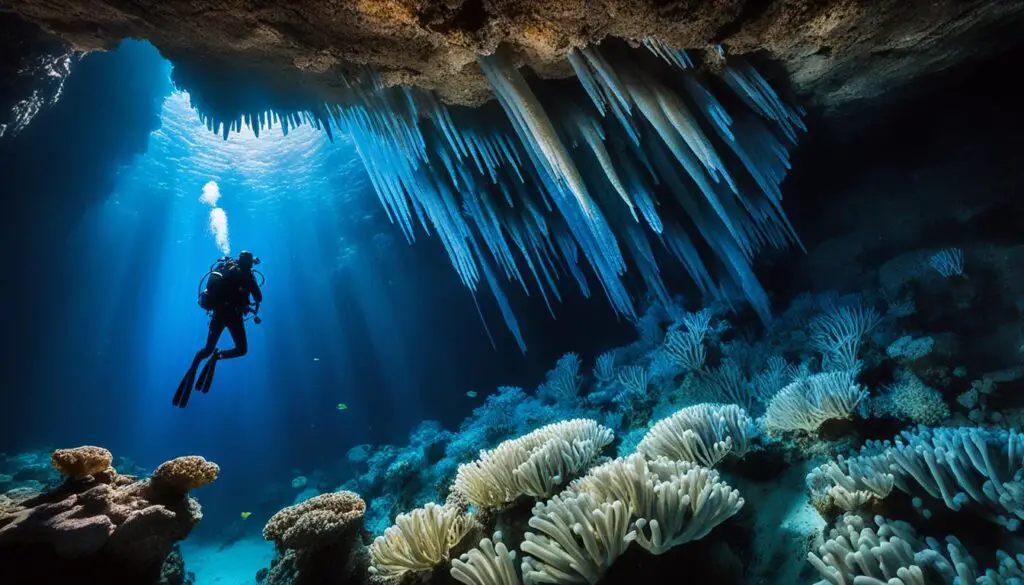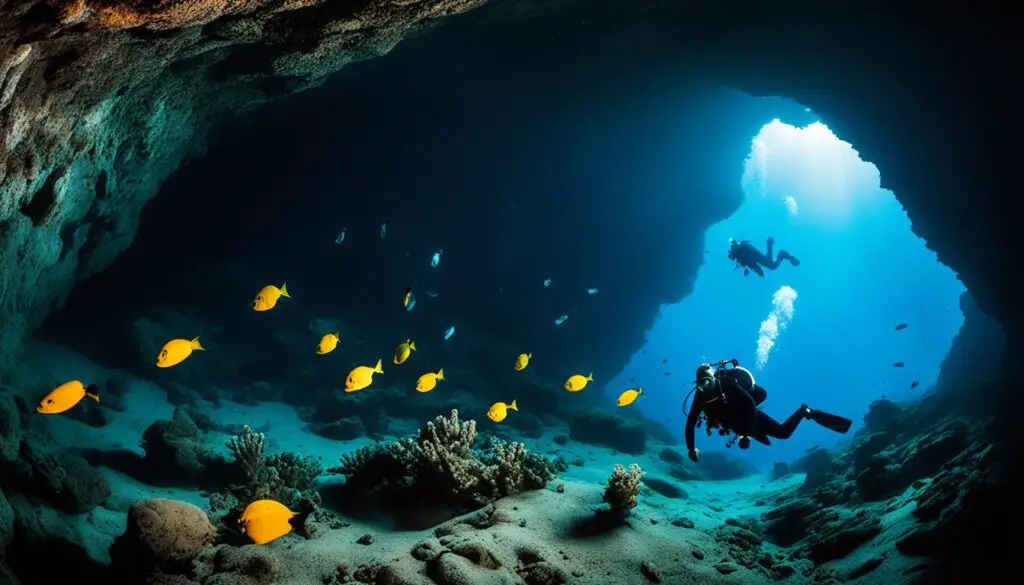Underwater cave exploration takes intrepid divers into the depths of the unknown. These uncharted aquatic realms offer thrilling adventures and pose unique challenges. From the mysterious darkness to the hidden wonders within, exploring underwater caves is an incredible journey that requires both skill and courage.
Imagine diving into an underwater cave, venturing into a realm where sunlight fails to penetrate. The darkness engulfs you as you descend further and further. Every turn could reveal a hidden passage or an awe-inspiring natural formation. The thrill of exploration pushes you forward, but also reminds you of the challenges that lie ahead.
As you navigate through narrow passageways and dive deeper into the unknown, you encounter mesmerizing sights that few have ever witnessed. Underwater caves often house breathtaking wonders, such as intricate rock formations, stalagmites, and stalactites. These natural formations are not only captivating, but also a testament to the immense power of nature over thousands of years.
However, the beauty of underwater caves comes with inherent dangers. The darkness itself is disorienting, making it crucial to rely on specialized training and equipment. Cave divers must possess a unique set of technical skills, including line laying, buoyancy control, and navigation, to safely explore these hidden realms. Additionally, appropriate equipment, such as rebreathers that recycle exhaled air, is essential to prolong dive times and minimize disturbances within the cave.
While the allure of underwater cave exploration is undeniable, it is imperative to remember the fragility of these ecosystems. Protecting the delicate balance within underwater caves is essential for preserving their unique biodiversity. Responsible diving practices and environmental preservation efforts are crucial to safeguarding these ecosystems for generations to come.
Key Takeaways:
- Underwater cave exploration offers thrilling adventures and unique challenges.
- Specialized training and equipment are necessary to navigate the darkness and ensure safety.
- Underwater caves feature breathtaking natural formations and hidden wonders.
- Protecting these delicate ecosystems is crucial for preserving biodiversity.
- Responsible diving practices and environmental preservation efforts play a vital role in safeguarding underwater cave ecosystems.
The Beauty and Peril of Underwater Caves
Underwater caves are a captivating world filled with hidden wonders and natural formations that leave divers in awe. These submerged caverns boast breathtaking beauty, showcasing magnificent stalagmites, stalactites, and intricate rock formations that have formed over thousands of years.
Exploring underwater caves is like diving into a secret realm, where nature’s artistic masterpieces are revealed. These hidden wonders are a testament to the awe-inspiring forces of nature, creating unique and mesmerizing landscapes beneath the water’s surface. As divers venture deeper into these caves, they are greeted with stunning sights that are found nowhere else on Earth.
“The beauty of underwater caves is unparalleled. It’s like entering a magical realm where time stands still, and nature’s artistry takes center stage.”
While the allure of underwater caves is undeniable, it’s essential to recognize the potential dangers they present. Cave diving requires specialized training and equipment to ensure safety in the dark and sometimes treacherous conditions. The darkness can be disorienting, and the confined spaces pose challenges for navigation and communication.
Divers must exercise caution and adhere to strict cave diving safety protocols. Proper planning, thorough knowledge of the cave system, and proficiency in advanced diving techniques are crucial to mitigating risks and ensuring a safe exploration. Equipment such as underwater lights, diving reels, and redundant breathing systems play a vital role in maintaining safety and managing emergencies.
Unveiling the Hidden Beauties
Underwater caves are home to a diverse array of natural formations that amaze and inspire. Let’s take a closer look at some of the remarkable wonders waiting to be discovered:
- Stalagmites and Stalactites: These stunning mineral formations grow inside caves as water drips from the ceiling, creating awe-inspiring columns that stretch from floor to ceiling or hang like icicles.
- Flowstones and Draperies: These delicate formations are created when water carrying minerals flows over surfaces, leaving behind mesmerizing patterns reminiscent of flowing fabric.
- Crystal Clear Pools: Underground lakes or cenotes, formed by the collapse of cave roofs, offer serene and transparent bodies of water that reflect the natural beauty of the surrounding cave walls.
- Anemone Gardens: These vibrant and colorful underwater ecosystems host a variety of marine life, providing a vivid contrast to the rocky cave environment.
Exploring these hidden wonders requires a delicate balance of fascination and respect for the fragile ecosystem. Preservation efforts and responsible diving practices are essential to protect these unique environments and sustain the remarkable beauty of underwater caves for future generations to enjoy.

By embracing the remarkable beauty and respecting the potential dangers of underwater caves, divers can embark on unforgettable adventures that provide a profound connection with nature’s wonders.
Technical Skills and Equipment for Cave Diving
Cave diving requires a unique combination of technical skills and specialized equipment to ensure a safe and successful exploration of underwater caves. Divers must possess an array of techniques, including cave diving techniques, proper use of rebreathers, and expertise in handling underwater cave equipment.
Cave Diving Techniques
Cave diving techniques are essential for maneuvering through the intricate passageways and conducting exploration within underwater caves. One crucial skill is line laying or using a guideline to maintain a visual reference and prevent disorientation in the dark cave environment. By laying and following a guide, divers can safely navigate the complex maze of tunnels and tunnels within underwater caves.
Buoyancy control is another vital technique for cave diving. Maintaining neutral buoyancy allows divers to move through confined spaces without causing disturbances that could dislodge sediments or disturb cave inhabitants. Proper buoyancy control also helps conserve energy and extend dive times.
Rebreathers
Rebreathers are a type of underwater breathing apparatus used in cave diving. Unlike traditional open-circuit scuba systems that release exhaled air as bubbles, rebreathers recycle and filter the exhaled air, removing carbon dioxide and replenishing oxygen. This closed-circuit system is advantageous in cave diving, as it minimizes bubbles that could interfere with visibility or disturb delicate cave formations.
Rebreathers also enable cave divers to stay submerged for longer periods, extending dive times and allowing for more extensive exploration. The reduced bubble activity associated with rebreathers also adds an element of safety by minimizing the risk of dislodging sediments or attracting predators in the cave ecosystem.
Underwater Cave Equipment
Proper equipment is essential for cave diving, as it enhances safety and efficiency in the challenging underwater cave environment. Some essential equipment includes:
- Primary and secondary dive lights: Cave divers rely on powerful, reliable dive lights to illuminate the darkness and navigate through the cave.
- Dive reels and spools: These tools are used for line laying, helping divers create a visual reference to ensure safe exploration and exit from the cave.
- Underwater compass: An underwater compass is crucial for navigation in the absence of natural light or visible landmarks within the cave.
- Cutting tools: Cave divers carry cutting tools such as knives or shears to free themselves from entanglement and remove potential obstacles during exploration.
- Dive computers: These devices assist divers in monitoring their dive profiles, depths, and decompression requirements to ensure a safe ascent and minimize the risk of decompression sickness.
By mastering cave diving techniques and utilizing specialized equipment like rebreathers, cave divers can explore the mesmerizing world hidden beneath the surface of underwater caves while minimizing their impact on this delicate and unique ecosystem.

Protecting Underwater Cave Ecosystems
Environmental preservation and cave conservation are of utmost importance to safeguard the delicate balance and unique biodiversity found in underwater cave ecosystems. These habitats exist in fragile environments, where even the slightest disturbance can have profound and long-lasting consequences. As responsible divers, we have a vital role to play in advocating for the protection of these remarkable underwater realms and raising awareness about their ecological significance.
Cave conservation efforts primarily focus on minimizing human impact on these delicate ecosystems. By practicing responsible diving techniques and following established guidelines, we can help reduce the disturbances caused by our presence. This includes avoiding contact with fragile formations, being cautious of potential pollution sources, and ensuring that nothing is removed or disturbed during our dives. Through our actions, we contribute to the overall preservation of these extraordinary natural wonders.
In addition to adopting responsible diving practices, promoting environmental preservation involves actively supporting initiatives aimed at protecting underwater cave ecosystems. This can include participating in clean-up activities to remove debris from cave entrances, educating and engaging with fellow divers, and collaborating with local conservation organizations.
Recognizing the ecological value of these fragile ecosystems is vital in inspiring ongoing efforts to conserve them. Underwater cave environments host unique and specialized species that rely on the intricate and interconnected dynamics of these habitats. By taking steps to protect these ecosystems, we are not only ensuring their preservation but also contributing to the greater understanding of our planet’s biodiversity and the importance of environmental conservation.
FAQ
What is underwater cave exploration?
Underwater cave exploration is a thrilling adventure that takes intrepid divers into the depths of uncharted aquatic realms. It involves exploring submerged caves and discovering hidden wonders within.
What can you find in underwater caves?
Underwater caves often feature breathtaking beauty and stunning natural formations such as stalagmites, stalactites, and intricate rock formations. These hidden wonders add to the allure and mystery of cave diving.
Is cave diving dangerous?
Cave diving can be dangerous due to the unique challenges it presents. The dark and sometimes treacherous conditions require specialized training and equipment to ensure safety. However, with proper preparation and skill, the risks can be mitigated.
What skills are required for cave diving?
Cave diving demands a unique set of technical skills, including proficiency in line laying, buoyancy control, and navigation. These skills are essential for safely exploring underwater caves and avoiding potential hazards.
What equipment is used in cave diving?
Cave divers utilize specialized equipment to enhance their safety and extend dive times. One example is rebreathers, which recycle exhaled air and minimize bubbles that could disturb the cave environment. Other essential equipment includes diving lights, dive reels, and communication devices.
Why is it important to protect underwater cave ecosystems?
It is crucial to protect underwater cave ecosystems to preserve their fragile balance and unique biodiversity. Cave conservation efforts focus on minimizing human impact, reducing pollution, and promoting responsible diving practices. By protecting these delicate environments, we can ensure their long-term survival and ecological significance.
